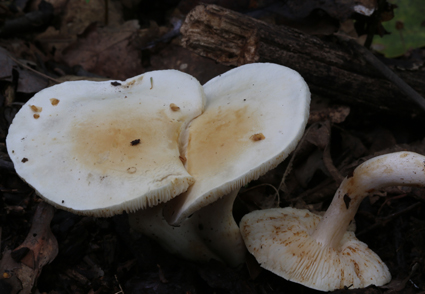Abstract
Tricholoma lishanense is described and illustrated from northern China based on both morphological and molecular data. Phylogenetic analyses based on sequence data from the ITS locus resolved the new species in section Lasciva of Tricholoma. Tricholoma lishanense can be diagnosed by its overall white basidiomata with a fragrant and pleasant odor, very narrow lamellae, different phylogenetic position and habitat under oaks.
References
Alfaro, M.E., Zoller, S. & Lutzoni, F. (2003) Bayes or bootstrap? A simulation study comparing the performance of Bayesian Markov chain Monte Carlo sampling and bootstrapping in assessing phylogenetic confidence. Molecular Biology and evolution 20 (2): 255–266. https://doi.org/10.1093/molbev/msg028
Bessette, A.E., Bessette, A.R., Roody, W.C. & Trudell, S.A. (2013) Tricholomas of North America: a mushroom field guide. University of Texas Press.
Bigelow, H.E. (1976) Studies on some lignicolous Clitocybes. Memoirs of the New York Botanical Garden 28: 9–15.
Bon, M. (1984) Les Tricholomes de France et d’Europe occidentale. Lechevalier, Paris. Encyclopédie Mycologique 36: 2–324.
Bulliard, J.B.F. (1791) Histoire des champignons de la France. I. Paris, 513 pp.
Castresana, J. (2000) Selection of conserved blocks from multiple alignments for their use in phylogenetic analysis. Molecular Biology and Evolution 17 (4): 540–552.
Christensen, M. & Noordeloos, M.E. (1999) Notulae ad Floram agaricinam neerlandicam—XXXVI. Tricholoma. Persoonia 17 (2): 295–317.
Christensen, M. & Heilmann-Clausen, J. (2013) The genus Tricholoma–Fungi of Northern Europe, vol. 4. Svampetryk, Denmark. 228 pp.
Ding, X.X., Xu, X. & Cui, Y.Y. (2023) A fifty-locus phylogenetic analysis provides deep insights into the phylogeny of Tricholoma (Tricholomataceae, Agaricales). Persoonia 50: 1–26. https://doi.org/10.3767/persoonia.2023.50.01
Dring, D.M. (1971) Techniques for microscopic preparation. In: Booth, C. (Ed.) Methods in microbiology. Vol. 4. New York: Academic Press. pp. 95–111. https://doi.org/10.1016/S0580-9517(09)70008-X
Gardes, M. & Bruns, T.D. (1993) ITS primers with enhanced specificity for basidiomycetes–application to the identification of mycorrhizae and rusts. Molecular Ecology 2 (2): 113–118. https://doi.org/10.1111/j.1365-294X.1993.tb00005.x
Gillet, C.C. (1874) Les Hyménomycètes ou Description de tous les Champignons (Fungi) qui Croissent en France avec l’indication de leurs propriétés utiles ou vénéneuses. Vol. 1. Alençon, Ch. Thomas. pp. 1–176. https://doi.org/10.5962/bhl.title.46975
Heilmann-Clausen, J., Christensen, M., Frøslev, T.G. & Kjøller, R. (2017) Taxonomy of Tricholoma in Northern Europe based on ITS sequence data and morphological characters. Persoonia 38 (1): 38–57. https://doi.org/10.3767/003158517X693174
Hillis, D.M. & Bull, J.J. (1993) An empirical test of bootstrapping as a method for assessing confidence in phylogenetic analysis. Systematic Biology 42 (2): 182–192. https://doi.org/10.1093/sysbio/42.2.182
Karsten, P.A. (1879) Rysslands, Finlands och den Skandinaviska halföns Hattsvampar. Förra Delen: Skifsvampar. Bidrag till Kännedom av Finlands Natur och Folk 32. pp. 1–571.
Katoh, K. & Standley, D.M. (2013) MAFFT multiple sequence alignment software version 7: improvements in performance and usability. Molecular Biology and Evolution 30 (4): 772–780. https://doi.org/10.1093/molbev/mst010
Kummer, P. (1871) Der führer in die Pilzkunde. Zerbst, 146 pp.
He, M.Q., Zhao, R.L., Hyde, K.D., Begerow, D., Kemler, M., Yurkov, A., McKenzie, E.H.C., Raspé, O., Kakishima, M., Sánchez-Ramírez, S., Vellinga, E.C., Halling, R., Papp, V., Zmitrovich, I.V., Buyck, B., Ertz, D., Wijayawardene, N.N., Cui, B.K., Schoutteten, N., Liu, X.Z., Li, T.H., Yao, Y.J., Zhu, X.Y., Liu, A.Q., Li, G.J., Zhang, M.Z., Ling, Z.L., Cao, B., Antonín, V., Boekhout, T., Silva, B.D.B., Crop, D.E., Decock, C., Dima, B., Dutta, A.K., Fell, J.W., Geml, J., Ghobad-Nejhad, M., Giachini, A.J., Gibertoni, T.B., Gorjón, S.P., Haelewaters, D., He, S.H., Hodkinson, B.P., Horak, E., Hoshino, T., Justo, A., Lim, Y.W., Menolli Jr., N., Mešić, A., Moncalvo, J.M., Mueller, G.M., Nagy, L.G., Nilsson, R.H., Noordeloos, M., Nuytinck, J., Orihara, T., Ratchadawan, C., Rajchenberg, M., Silva-Filho, A.G.S., Sulzbacher, M.A., Tkalčec, Z., Valenzuela, R., Verbeken, A., Vizzini, A., Wartchow, F., Wei, T.Z., Weiß, M., Zhao, C.L., Kirk, P.M. (2019) Notes, outline and divergence times of Basidiomycota. Fungal Diversity 99: 105–367. https://doi.org/10.1007/s13225-019-00435-4
Nylander, J. (2004) MrModeltest 2.2. Computer software distributed by the University of Uppsala. Sweden: Evolutionary Biology Centre.
Page, R.D. (2001) TreeView. Glasgow University, Glasgow.
Peck, C.H. (1872) Report of the Botanist (1870). Annual Report on the New York State Museum of Natural History 24: 41–108.
Ronquist, F. & Huelsenbeck, J.P. (2003) MrBayes 3: Bayesian phylogenetic inference under mixed models. Bioinformatics 19 (12): 1572–1574. https://doi.org/10.1093/bioinformatics/btg180
Ryberg, M. & Matheny, P.B. (2011) Asynchronous origins of ectomycorrhizal clades of Agaricales. Proceedings of the Royal Society B: Biological Sciences 279 (1735): 2003–2011. https://doi.org/10.1098/rspb.2011.2428
Shangguan, T.L., Zhang, F. & Fan, L.S. (2000) Analysis on the flora of xylophyta in Zhongtiao mountains. Bulletin of Botanical Research 20 (2): 143–155.
Singer, R. (1947) New genera of fungi. III. Mycologia 39: 77–89. https://doi.org/10.2307/3755289
Stamatakis, A. (2014) RAxML version 8: a tool for phylogenetic analysis and post-analysis of large phylogenies. Bioinformatics 30 (9): 1312–1313. https://doi.org/10.1093/bioinformatics/btu033
Staude, F. (1857) Die Schwämme Mitteldeutschlands, in besondere des Herzogthums. Coburg, Germany, 125 pp.
Tedersoo, L., May, T.W. & Smith, M.E. (2010) Ectomycorrhizal lifestyle in fungi: global diversity, distribution, and evolution of phylogenetic lineages. Mycorrhiza 20: 217–263. https://doi.org/10.1007/s00572-009-0274-x
White, T.J., Bruns, T., Lee, S. & Taylor, J. (1990) Amplification and direct sequencing of fungal ribosomal RNA genes for phylogenetics. In: Innis, M., Gelfand, D., Sninsky, J. & White, T. (Eds.) PCR Protocols: A guide to Methods and Applications. Vol. 18 (1). Academic Press, pp. 315–322. https://doi.org/10.1016/B978-0-12-372180-8.50042-1
Xu, X., Cui, Y.Y. & Yang, Z.L. (2020) Two new species of Tricholoma sect. Genuina (Agaricales) from China. Phytotaxa 443 (2): 155–166. https://doi.org/10.11646/phytotaxa.443.2.3
Yang, Z.L., Ding, X.X., Kost, G. & Rexer, K.H. (2017) New species in the Tricholoma pardinum complex from Eastern Himalaya. Phytotaxa 305 (1): 1–10. https://doi.org/10.11646/phytotaxa.305.1.1


